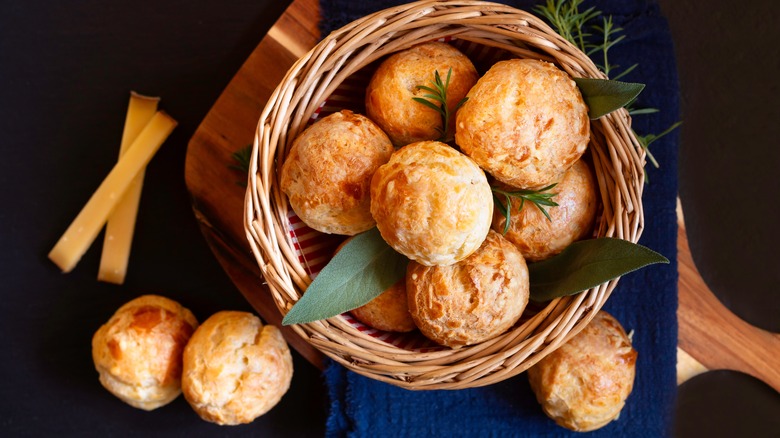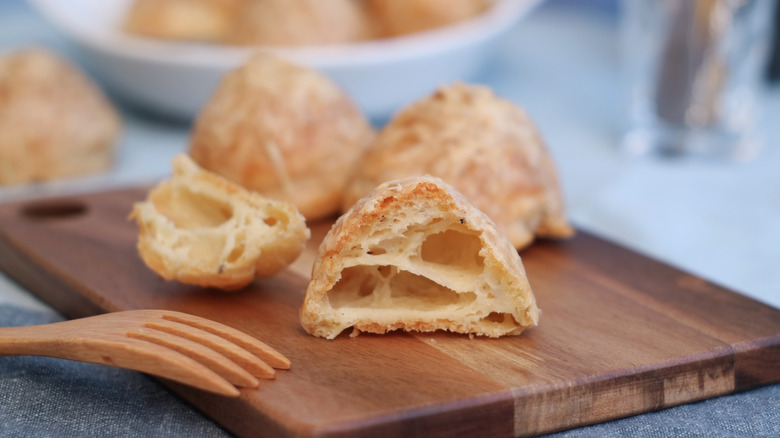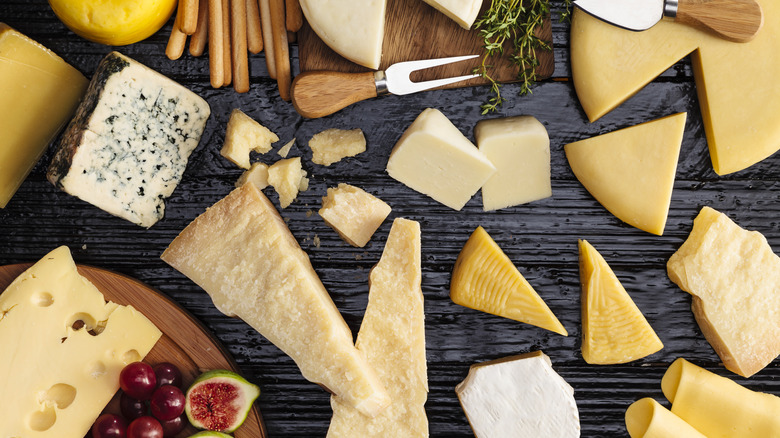The Best Kind Of Cheese To Use When Making Gougères
Light, rich, and crisp, famously delicious French gougères are, to put it simply, savory cheese puffs. To make gougères, you must first make pâte à choux, a delicate dough of water or milk, eggs, butter, flour, and seasonings. Choux pastry is well-known as the pastry of éclairs and cream puffs, those delicate sweets filled with an indulgent pastry cream. Unlike those sweets, gougères are typically left hollow to emphasize their prized light-and-airy characteristics. Gougères are typically served as hors d'oeuvres, a small appetizer before a meal, so weightlessness is key.
Making choux takes patience and finesse but selecting the best cheese to mix into the dough isn't nearly as tricky. The best cheese to use in gougères is a hard or semi-hard variety. This is because a drier cheese has a relatively low moisture content, which allows these puffs to get that signature rise and hollow interior as they bake in the oven. Incorporating a creamier or softer cheese, like brie or St. Andre, into the gougères dough risks compromising the height and weighing down the crispy, light characteristics of the puff. Luckily, there are plenty of cheeses that fall into the hard or semi-hard category, as well as multiple ways to twist it up.
Selecting and prepping the perfect gougères cheese
There are three cheeses most commonly used in gougères: gruyère, comté, and emmental. Gruyère is the classical option as its firm texture and salty-sweet flavor profile deliver the optimum gougères baked consistency and flavor. Comté is similar to gruyère in taste and texture, with slightly more nutty and buttery tones. Emmental, also called Emmentaler, is a semi-hard cheese somewhat milder in taste than gruyère.
Parmesan is a less conventional hard cheese you may also consider grating into your choux pastry because ticks the firm-dry texture box while also delivering a pronounced flavor profile that is tangy, sharp, and richly nutty. Asiago, a semi-hard cow's milk cheese also originally from Italy, works well in gougères, as does Spanish Manchego, as both have flavors similar to Parmesan but milder and that pair excellently with light choux pastry.
Any of these cheeses can be used for gougères, however, it's advised to buy a block and grate the cheese just before you use it. Pre-grated cheeses can get tough and rubbery the longer they sit, and the shred of the cheese is typically larger and thicker than the fine grate needed for gougères. Larger pieces of grated cheese can actually weigh down the light choux pastry and affect its fluffy rise.
Widen your gougères cheese horizons
Other cheeses, such as Swiss or cheddar, can also be used in gougères. Aged cheeses are also a consideration because they tend to have a more crumbly consistency. Older cheese develops additional enzymes and microbes as it ages, resulting in a drier, stronger cheese. An aged Swiss or cheddar with less moisture is less likely to weigh down and flatten the gougères' rise.
More cheese options give you the freedom to experiment with different cheeses in your gougères or mix cheeses for unexpected and exciting flavor combinations. Try a mix of mellow gruyère with pungent parmesan or sharp cheddar for a delectably cheesy mouthful.
Savory spices such as fresh thyme, ground nutmeg, or cayenne pepper can also be sprinkled into the pastry to complement the flavors of the cheese. If you like the idea of filling the typically hollow puffs, a cheese custard works well. Made simply from a combination of cheese, double cream, and eggs, the custard is piped into the puffs once they have cooled for at least 5 minutes.
If you've previously used soft cheese to make gougères, it's time to switch up the game and make these cheese puffs with hard or semi-hard varieties.


